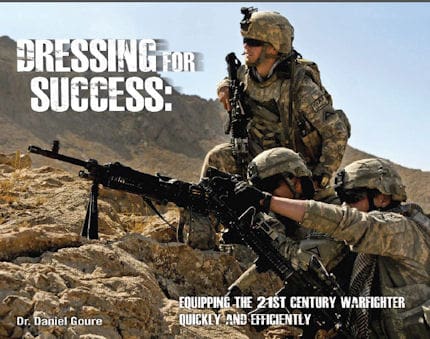This legislation is significant because only PM-ICE existed before the war started. It shows how important protecting American warriors is for Congress. For the Army, PEO Soldier and the associated funding for the huge advancements we have seen in Soldier Systems came along with the war. Funding thus far for all services has been via supplementals or in some cases via regrogramming actions. The Army is in the midst of developing a baseline budget for the Soldier Systems commodity area so that it can find its place in the Future Years Defense Plan. It is imperative that the gains already made are not lost due to loss of focus.
The Warrior Protection and Readiness Coalition (WPRC) today applauded both passage of the FY 2012 National Defense Authorization Act (NDAA) and the bill’s strong focus on warfighter clothing and equipment budgeting.
In the bill, Section 1094 requires that for the first time that the Military Departments provide an up-front, specific outline of their annual budget plans for the specialized products that protect warfighters from the enemy and the elements in theatre. Beginning in FY2013, the Army, Navy, Air Force and Marine Corps will now provide the President, in their budget request, an overview of spending plans for Organizational Clothing and Individual Equipment (OCIE).
With military budgets facing cuts in coming years, the WPRC believes this language will place a new level of emphasis on the need to provide America’s men and women in uniform with the best protective clothing and equipment.
As David Costello, Executive Director of the WPRC noted, “Over the past decade, the Department of Defense has made enormous progress in the development and fielding of protective clothing and equipment to the warfighter. This success is a direct result of domestic industry rising to the task of properly outfitting those who bravely serve our country. This new congressional requirement will give those companies, who manufacture in the US, much more predictability in terms of budget planning. Most importantly, it will help ensure that our men and women in uniform continue to receive the clothing and equipment that is essential to their mission success. This is a key step in making sure that these critical products and programs are sustained to meet future challenges.â€
For two years, the WPRC has been an advocate for the clothing and equipment needs of service members and for the industry that supports them. A broad bi-partisan group of Representatives and Senators have supported the WPRC on this key issue. In particular, the WPRC is grateful for the leadership of House Armed Services Committee Chairman Howard “Buck†McKeon (R-CA) and House Armed Services Committee Member Rep. Bill Owens (D-NY).
“This legislation helps ensure America’s warfighters have the tools to stay safe, complete their mission, and secure the nation,†said Congressman Owens. “It is absolutely critical that we continue to offer complete support to the men and women engaged in Afghanistan, even as America responsibly winds down the war in Iraq. We have also taken steps in this legislation to help small businesses that do business with the Department of Defense better plan their operations by giving them a clearer sense of DoD’s future needs.â€
The WPRC is an advocacy organization for the industry that manufactures and distributes clothing and equipment that saves lives, and that helps warfighters complete their missions effectively. The WPRC membership represents a cross section of a vital sector that helps maintain the strength of American manufacturing. The WPRC membership includes: ADS, Inc., Bates Footwear, Benchmade Knife Company, Bluewater Defense, Brookwood Companies, Inc., Darn Tough Vermont, DuPont, Duro Textiles, LLC, Eye Safety Systems, Inc., ForceProtector Gear, Honeywell, Insight Technology, Inc., International Textile Group, Inc., Leading Technology Composites, Inc., London Bridge Trading Company, Milliken & Company, New Balance Athletic Shoe, Inc., Otis Technology, Inc., Outdoor Research, Pelican Products, Inc., Polartec, LLC, Silynx Communications, Inc., Smith Optics, Surefire, LLC, Tactical Holdings, TenCate Protective Fabrics, W.L. Gore & Associates, Inc., Wilcox Industries Corp., Wild Things Tactical, and Wiley X, Inc.
For more information on the Warrior Protection & Readiness Coalition, please visit www.warriorprotection.net.














































































































